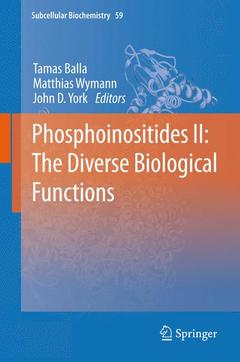Description
Phosphoinositides II: The Diverse Biological Functions, 2012
Subcellular Biochemistry Series, Vol. 59
Language: English
Subject for Phosphoinositides II: The Diverse Biological Functions:
Keywords
Publication date: 04-2014
460 p. · 15.5x23.5 cm · Paperback
Publication date: 03-2012
460 p. · 15.5x23.5 cm · Paperback
Description
/li>Contents
/li>Comment
/li>
1. Ca2+ signalling by IP3 receptors. - 2. Phosphoinositide signaling during membrane transport in Saccharomyces cerevisiae. - 3. Phosphoinositides in the mammalian endo-lysosomal network. - 4. Role of PtdIns(4,5)P2 in vesicle exocytosis and membrane fusion. - 5. Role of phosphoinositides at the neuronal synapse. - 6. Phosphatidylinositol 4,5-bisphosphate and the actin cytoskeleton. - 7. Phosphoinositides in chemotaxis. - 8. Phosphoinositides in Golgi complex function. - 9. Sec14 like PITPs couple lipid metabolism with phosphoinositide synthesis to regulate Golgi functionality. - 10. Phosphoinositide sensitivity of ion channels, a functional perspective. - 11. Nuclear phosphoinositides: location, regulation and function. - 12. Phosphoinositides and cellular pathogens. - 13. Defining signal transduction by inositol phosphates. - 14. Cell signalling by inositol pyrophosphates.



